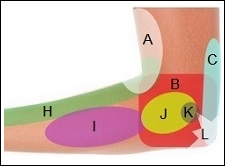- Home
- Shoulder Anatomy
- Elbow ROM
Elbow Range of Motion
Written By: Chloe Wilson BSc (Hons) Physiotherapy
Reviewed By: SPE Medical Review Board

Elbow range of motion (ROM) often becomes restricted following an injury.
This can impact day to day activities, and left untreated, may get progressively worse.
When we talk about elbow range of motion, we are looking at the amount of movement there is at the elbow joint.
The main movements of the elbow are flexion and extension (bending and straightening the elbow) and pronation and supination (rotating the palm up and down).
We are constantly using our arms and moving our elbows throughout the day, whether we are typing, having a cup of coffee, eating, picking things up, carrying things or even just talking on the phone. So having good flexibility and mobility is the elbow is really important.
What Is Elbow Range Of Motion?
There are three different types of elbow range of motion:
- Active Elbow ROM: how far the elbow can move in one direction on its own i.e. movement it caused by muscle contraction without any external help
- Passive Elbow ROM: how far the elbow can move in one direction when moved by an external force i.e. someone else moves the elbow while the muscles are completely relaxed
- Active Assisted Elbow ROM: how far the elbow can move in one direction when it is weak or in pain with some assistance i.e. the muscles are partially contracting to move the elbow but with some help e.g. from a physical therapist
In a normal, healthy elbow joint, these three range of motions will be fairly similar with passive elbow range of motion being slightly greater than active range of motion.
But if you have injured your elbow, have pain in the arm or an elbow condition such as arthritis or bursitis, then your range of motion is likely to be reduced, with active elbow range of motion being most affected. If you want help working out what is wrong visit the elbow pain diagnosis section.
What Is Normal Elbow Range Of Motion?
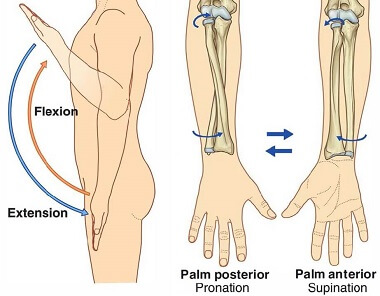
Normal elbow range of motion refers to how much the elbow bends, straightens and twists.
The twisting movements actually occur between the forearm bones, radius and ulna, but are usually considered to be part of elbow motion.
Normal active elbow range of motion is:
- Flexion ROM: normal active elbow flexion range of motion is 140o-150o i.e. fully bent
- Extension ROM: normal active elbow extension range of motion is 0o i.e. fully straight
- Pronation ROM: normal active pronation range of motion is 75o-85o i.e. palm facing down
- Supination ROM: normal active supination range of motion is 80o-90o i.e. palm facing up
Normal passive elbow ROM is:
- Passive Elbow Flexion: up to 155o, depending on the size of the upper arm – the limit is the forearm pushing onto the biceps muscles
- Passive Elbow Extension: up to 10o hyperextension is considered normal
- Passive Pronation: up to 90o
- Passive Supination: up to 95o
Functional range of motion refers to the amount of movement needed to do normal activities of daily life such as eating, drinking and brushing your hair.
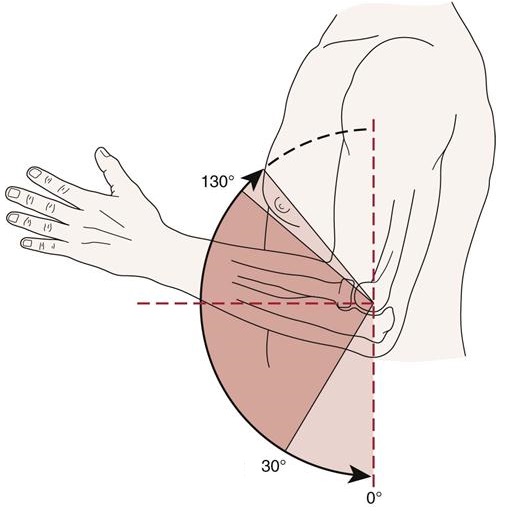
At the elbow joint, most functional activities require around 100 degrees of flexion/extension and rotation:
- Elbow Flexion/Extension: 30-130o i.e. from 30o off extension to 130o flexion
- Pronation/Supination: 50o-50o i.e. 50o pronation and 50o supination from neutral
This means you can still perform most daily activities even if you have lost 20o-30o of motion in any direction.
Normal elbow range of motion required for common activities of daily living are:
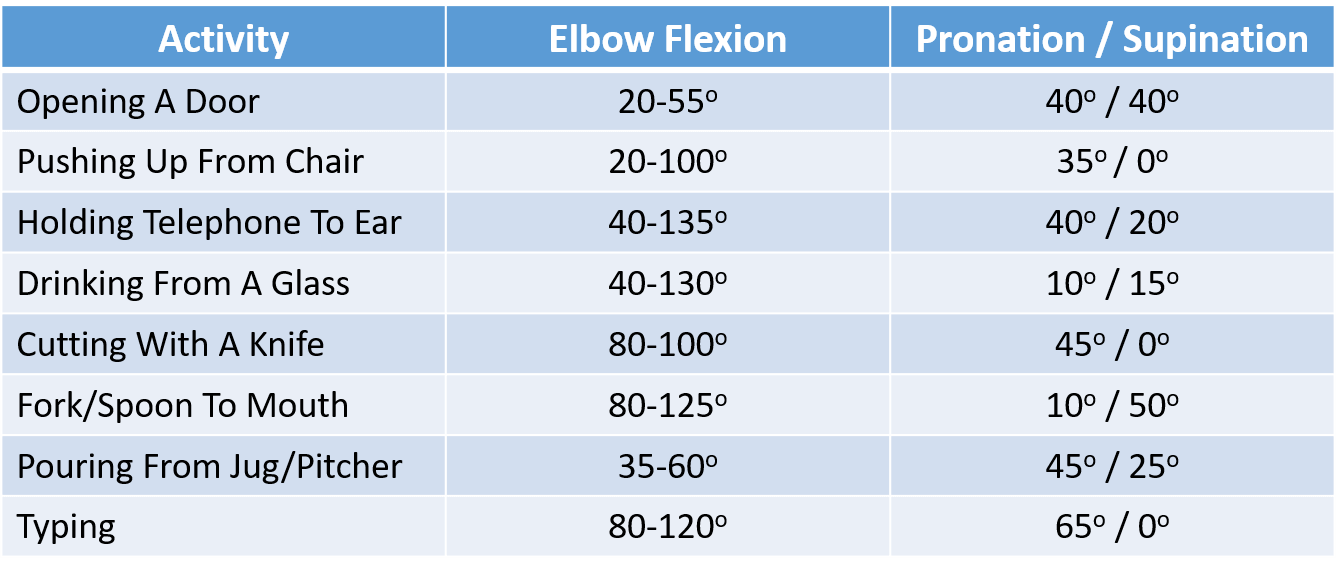
Losing end range flexion has more of a functional impact than losing end range extension in the elbow.
Having a range of 30o-130o of flexion allows for around 80% of normal forearm and hand function but outside this range, losing more flexion has a greater impact than losing more extension, at a ratio of around 2:1.
This means that every degree of flexion lost is roughly equivalent to 2 degrees further extension loss in terms of functional impact.
Anything that interferes with normal elbow movement can cause pain. There may be:
- Medial Elbow Pain: pain on the inner side of the elbow
- Lateral Elbow Pain: pain on the outer side of the elbow
- Posterior Elbow Pain: pain at the back of the elbow
- Forearm Pain: pain in the forearm region
RELATED ARTICLE: Shoulder Range Of Motion
How To Measure Elbow ROM
Using a goniometer is the most accurate way to measure elbow range of motion in all directions. A goniometer is a simple device that measures angles – it looks like a circular protractor with two arms!
In the middle of the goniometer is a circle which shows a full 360o arc. Out of this comes two arms, a stationary arm that extends out of the circle and a moveable arm.
When using a goniometer to measure elbow motion, it is much easier to get someone else to do the measuring for you – it’s hard to try and line everything up and get an accurate yourself.
How To Measure Flexion/Extension
When measuring elbow flexion and extension range of motion, you must first identify three landmarks on the arm
- Elbow - Lateral Epicondyle: bony lump on the outer side of the elbow
- Shoulder – Acromion Process: bony lump on the outer side of the shoulder
- Wrist - Radial Styloid: bony lump on the outer side of the wrist
To find the acromion, place one hand on top of your opposite shoulder. Walk your fingers out to the edge of your shoulder across a flat ledge. When you reach a dip, you have reached the edge of the acromion process and dropped down onto the humeral head. Butt your fingers in and up against the edge of the acromion, feel along the edge from front to back and find the mid-point. Line the stationary arm of the goniometer up to that point.
The lateral epicondyle is the slightly lower of the two lumps on the outer side of the elbow. It sits just below the joint line (the small dip between the upper arm bone and forearm bone). Line the centre of the goniometer circle up with this point.
The radial styloid is the bony lump on the outer side of your wrist directly below the base of the thumb. Line the moveable arm of the goniometer up with that point.
- Either lie down on your back with a pillow or rolled up towel underneath your upper arm (making sure the elbow hangs freely), or sit with the arm down by your side, elbow against your waist.
- Place the axis of the goniometer over the lateral epicondyle
- Line the stationary arm of the goniometer with the middle of the acromion process
- Line the moveable arm of the goniometer up with the radial styloid
Measuring Elbow Flexion
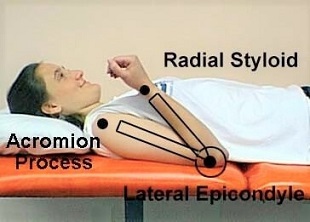
- To measure active elbow flexion, bend the elbow as far as you can with your palm facing up, without moving the upper arm
- To measure passive range have someone gently push through the back of your forearm near your wrist to see if there is any extra movement
The normal end feel of elbow flexion range of motion is soft and springy as the movement is limited by your biceps muscles.
Measuring Elbow Extension
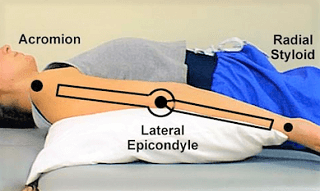
- To measure active elbow extension, bring the arm down straight and the forearm back as far as you can, keeping the upper arm in line with your body
- To measure passive range of motion support the back of the upper arm and gently push back through the front of the forearm
The normal end feel of elbow extension range of motion is hard as the bones (olecranon process of the ulna and olecranon fossa of the humerus) interlock and prevent further movement.
Hyperextension injuries occur when the elbow is forced backwards and bends back to far - you can find out all about the common causes, symptoms, diagnosis and treatment in the hyperextended elbow section.
How To Measure Pronation / Supination
To measure pronation and supination range of motion you are going to be lining the goniometer up with the:
- Ulna Styloid: the bony lump just below the inner side of the wrist (little finger side)
- Humerus: the upper arm bone
- Distal Radius: the forearm bone
Measuring Supination
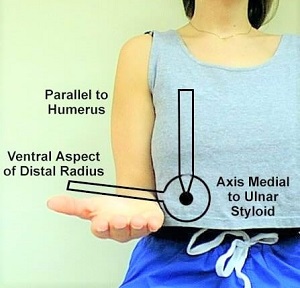
- Sit or stand with your elbow bent 90 degrees, and turn your palm up
- Line the axis of the goniometer up just below the ulna styloid as shown and have the stationary arm parallel to the humerus (upper arm bone)
- Bring the moveable arm of the goniometer down so it rests across the front of the forearm, just below the wrist
- To measure active range of motion, bring your wrist and thumb back as far as you can to get full rotation and measure the angle.
From here you can measure passive supination by grasping the back of the forearm and gently twisting it as far round as possible.
The normal end feel of supination range of motion is firm / elastic as movement is limited by tension in the ligaments
Measuring Pronation
This is very similar to measuring supination, but this time you turn the palm down and measure from the other side of your wrist.
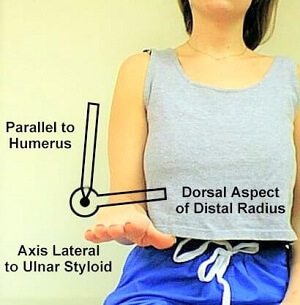
- Sit or stand with your elbow bent 90 and turn your palm to face down
- Line the axis of the goniometer up just below the ulna styloid on the outer side of the wrist as shown and have the stationary arm parallel to the humerus
- Rest the moveable arm of the goniometer across the back of the forearm, just below the wrist
- To measure active pronation range of motion, twist your palm and thumb down as far as you can to get full rotation.
From here you can measure passive pronation by grasping the back of the forearm just below the wrist and gently twist it as far round as possible.
As with supination, the normal end feel of pronation is firm/elastic as movement is limited by ligament tension.
How To Measure Elbow ROM Without A Goniometer
If you don’t have a goniometer, you can still assess your elbow range of motion. This can help you to identify and areas of stiffness or limitation and allow you to see what progress you are making with rehab. It’s not as accurate as using a goniometer but it can still give useful feedback.
Measuring Elbow Flexion
- Sit/stand with your arm by your side and
- Bend elbow as much as you can, palm facing up (keep upper arm in-line with your body).
- Use a tape measure to measure the distance between your wrist and your shoulder.
Measuring Elbow Extension
- Stand with your back against a wall, elbows bent right angles, back of your arm against the wall
- Straighten your elbow bringing the back of your hand towards the wall
- If your hand touches the wall, you have full extension (0o). If it doesn’t, measure the distance from the back of your hand to the wall
Measuring Pronation
- Sit or stand with your elbow bent 90o and your forearm resting flat on a table
- Hold a pencil in your fist so that the end of it is sticking up and pointing towards the ceiling.
- Twist your hand round so that your palm is facing downwards keeping your elbow and upper arm still
- Measure the distance from the end of the pencil to the table
Measuring Supination
- Same starting position as for pronation but this time twist the hand the other way so the palm is facing up (still gripping the pencil in a fist).
- Measure the distance from the end of the pencil to the table
While these methods for measuring elbow range of motion won’t give you an actual measurement of movement in degrees, it does gives you something to compare with to monitor your progress when trying to improve elbow motion.
Other Options
Another possibility for measuring elbow range of motion is to use a goniometer app on your phone. There are various different ones out there for Apple and Android phones and they do vary in quality but this article in Gerontology & Geriatrics Studies Journal compares some of the most popular ones.
Alternatively, take a photo of yourself performing each different movement and then measure the angle between your shoulder and forearm (for flexion and extension) or your shoulder and the pen you are holding (for pronation and supination) with a protractor.
What Restricts Elbow ROM?
There are a few different things that can restrict forearm and elbow range of motion including:
- Pain: in some cases pain can be severe enough that it stops us from wanting to move the elbow and our brain blocks the movement
- Swelling: an increase in fluid inside or around the elbow joint can limit movement e.g. from bursitis or an injury. Even a small amount of swelling that might not be visible to the naked eye can have an impact. There may be generalised swelling around the joint or a specific lump on elbow. In most cases, non-steroidal anti-inflammatories, compression bandages and regular ice can help to reduce elbow swelling and improve range of motion
- Injury: damaging one of the structures in or around your elbow can interfere with elbow movement e.g. fracture, tendonitis, ligament tear, hyperextended elbow
- Muscle Tightness: if there is tightness in the arm muscles, it can limit how much the elbow can move e.g. bicep tightness is a common cause of restricted elbow extension. Muscle tightness is common after a period of immobilisation e.g. arm in a sling, with nerve damage or certain medical conditions. Arm stretches are the best way to combat this
- Muscle Weakness: if there is moderate to severe loss of muscle power, usually following an injury, then it may restrict elbow motion. Strengthening exercises are the best way to combat this
- Impingement: if something gets stuck inside the elbow joint it can block movement e.g. osteophytes
- Wear & Tear: degeneration of the elbow bones can lead to the formation of bone spurs and reduced joint space which limits elbow movement. This may be part of the normal aging process of from arthritis
If you want help working out what is causing your elbow pain or restricting your movement, visit the elbow pain diagnosis section.
How To Improve Elbow ROM
The best way to improve elbow range of motion is usually through a combination of:
- Medication: to get pain and inflammation under control
- Stretches: stretching out the upper arm and elbow muscles through exercises, particularly biceps stretches and general upper arm stretches
- Strengthening Exercises: improve the strength, stability, control and endurance of the upper arm, elbow and forearm muscles. Strengthening the scapular stabilisers can also really help as they ensure your shoulder is in the correct position, without which elbow motion can be affected
- Keep Active: our bodies and joints are designed to be active and our muscles need to be used to stop them getting tight and weak. Regular exercise e.g. jogging, swimming or cycling helps to keep us moving properly and prevent joint stiffness
- Heat/Ice: Using heat and/or ice can help to improve elbow range of motion. Ice is most helpful in the early stages following an injury to help reduce swelling, but with chronic elbow stiffness, heat can help to relax the soft tissues and improve flexibility
- Joint Mobilisations: manual techniques performed by a physical therapist can really help if joint stiffness is the culprit. They help to restore the natural spin, glide and roll movements that occur as the elbow moves to allow it to move freely, smoothly and fully. They should only be carried out by an experienced physical therapist and should be combined with exercises for the best long term outcome
What Else Can Help?
If your elbow range of motion is restricted, it is really important to understand why in order to get the best treatment, so make sure you get checked out by your doctor and have a look at the elbow pain diagnosis section.
In most cases, unless there is a severe injury, a combination of medication, stretching exercises, strengthening exercises and ice/heat are the best ways to improve elbow mobility.
It takes times for elbow range of motion to improve so stick with it, and only measure your range once or twice a week – there’s no need to do it more often.
You may also be interested in the following articles:
Related Articles
Page Last Updated: November 12th, 2024
Next Review Due: November 12th, 2026

